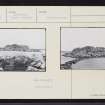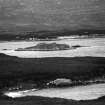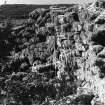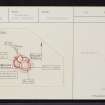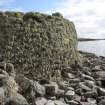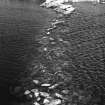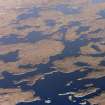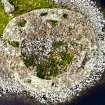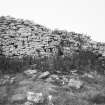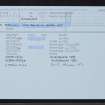Pricing Change
New pricing for orders of material from this site will come into place shortly. Charges for supply of digital images, digitisation on demand, prints and licensing will be altered.
North Uist, Loch An Duin, Dun Torcuill
Broch (Iron Age)
Site Name North Uist, Loch An Duin, Dun Torcuill
Classification Broch (Iron Age)
Canmore ID 10364
Site Number NF87SE 3
NGR NF 88885 73730
Datum OSGB36 - NGR
Permalink http://canmore.org.uk/site/10364
- Council Western Isles
- Parish North Uist
- Former Region Western Isles Islands Area
- Former District Western Isles
- Former County Inverness-shire
Field Visit (10 August 1914)
Dun Torcuill
On an island about 35 yards south-east of a promontory on the west side of Loch an Duin, some 3 ¾ miles north-west of Lochmaddy, is Dun Torcuill, which though dilapidated is still the best example of a broch on North Uist. The island is connected the shore by a broad causeway, never less than 6 feet in width, which, springing from mass of rock at the end of the promontory, extends east and south in a fine curve, advantage being taken of a rock which rises above the loch about midway in its course.
The broch, built of good drystone masonry, occupies the south-east and larger portion of the island. The walls have a slight inward batter and reach to a height of 9 feet on the north-west, and about 10 ½ feet on the south. They vary considerably in thickness from 7 ½ feet at the north and south-west to 10 feet at the east and 12 ½ feet at the west-north-west, where an entrance passage, now much broken down and obscured by fallen debris, shows a width of 3 ¾ feet at its internal extremity. The interior of the broch, which is roughly circular with a diameter of 38 feet, is filled to a depth of about 4 feet with stones obscuring all entrances to internal structures. On the northern arc access to a portion of a ground-level gallery, of which some 15 feet is fairly clear of debris, is now gained only through a hole in the roof. This gallery is set almost midway in the thickness of the wall and is approximately 2 ½ feet wide at the floor and 2 feet wide at the roof, which apparently formed the floor of an upper gallery, of which a short section of the inner wall remains to a height of about 4 feet. In the southeast segment of the wall there has been a stair, 2 feet 8 inches wide, with its outer wall showing a thickness of 4 feet 3 inches, and the inner wall 2 feet 4 inches. In the south-west segment there has been an oval-shaped chamber 18 feet long, 3 feet wide and 4 feet 10 inches in height.
Immediately adjoining the main construction, and occupying the north-western part of the island, are three annexes of irregular shape and apparently of later construction. The walls of these annexes are 4 ½ feet thick, but they are clearly built of re-used stones and the character of the masonry is different from that of the broch construction. That they had nothing to do with the main construction is shown by the fact that an annexe wall starts from the broch entrance, which it completely closes. There are traces of even earlier foundations within the annexes. The structures suggest in their layout that, at the time they were built, the broch was already ruinous and, therefore, deserted.
RCAHMS 1928, visited 10 August 1914
OS map: xxxi
Desk Based Assessment (29 December 1964)
Dun Torcuill is perhaps the finest example of a broch in North Uist (it is considered by Feachem (1963) to be a galleried dun).
Connected to the shore by a massive causeway, the island is completely walled around its edge, the southern and larger part being occupied by the broch proper, while the remainder forms an annexe enclosed within a separate rampart.
The central area contained a secondary erection of oblong shape similar to that at Dun an Sticer (NF87NE 1) and is probably dated 1542-1618 (E Beveridge 1911) . Full description and plan (RCAHMS 1928).
Information from OS (BRS) 29 December 1964
Field Visit (20 June 1965)
Dun Torcuill is a galleried dun and not a broch. It measures 18.6m NW to SE by 16.3m, with walls from 2.3m to 3.8m thick and up to 3.0m high externally and 2.1m internally. The entrance and gallery are still visible in the NW arc.
The 'secondary erection' noticed by Beveridge is obscured by tumbled stone which occupies the whole of the centre.
Adjoining the outer wall-face of the dun on the N are two later enclosures, with walls up to 1.9m thick and 1.3m high, the more westerly of which blocks the entrance to the dun. Traces of a tumbled drystone wall, 0.8m maximum height, start from the wall-junction of the N enclosure, continue around the water's edge on the W side of the islet and then possibly rejoin the west side of the dun: debris from the dun hides any other indications of the an outer curtain wall alleged by Beveridge.
See photos and 1/1250 sketch (on Record Card).
Surveyed at 1/10560.
Visited by OS (N K B) 20 June 1965.
Publication Account (2007)
NF87 4 DUN TORCUILL ('Dun Torquil')
NF/889737
This unexcavated broch, probably ground-galleried, in North Uist stands on an islet in Loch an Duin, about 35m south-east of a promontory on the west shore; it is the best preserved example on both Uists and Benbecula (visited in 1971, 14/8/85 and 24/6/88). A broad stone causeway more than 1.8m (6 ft) wide runs in a shallow curve between the promontory and the island [4, fig. 107]; there are what look like sheep enclosures at the broch end of the causeway [4, 53]. The structure has been called a 'galleried dun' but the only reason for distinguishing it from a broch seems to be the slightly oval ground plan [5].
Description
Thomas' description [2] is fairly brief and he mentions only a “gallery or passage” in the wall about 76cm (2 ft 6 in) wide and interrupted by stairs in at least two places.
The building occupies almost the whole area of the islet, the wallfaces being festooned with lichen; the inner face stands nearly 2m above the rubble in places. The outer face has a slight batter and in 1914 it reached 2.7m (8.6 ft) in height on the north-west and 3.20m (10.5 ft) on the south [4]. The wall varies considerably in thickness, being 2.29m (7.5 ft) on the north and south-west sides, 3.05m (10.0 ft) on the east and 3.81m (12.5 ft) on the west-north-west; of course these thicknesses have been taken some distance above the primary floor level.
The dilapidated entrance is on the west-north-west but no door-frame can be seen at present; the width of the passage at the outer end is 1.14m (3.75 ft). A stretch of lintelled ground level gallery can be seen at about 9 o'clock on the northern arc and access into this is available by a gap in the lintels. One can thus determine that the gallery is 76cm (2.5 ft) at its floor and 60cm (2 ft) at its roof. There seems to have been an upper gallery on top of it; a short section of the inner wallface of the latter remains to a height of about 1.22m (4 ft). The top of the first flight of the intra-mural stair can be seen in the south-east arc, at about 1 o'clock, and the lintel of the doorway connecting this with the central court can be seen at about 12 o'clock, or about 3m anti-clockwise. A mural chamber is in the south-west, some 5.49m (18 ft) in length and 92cm (3 ft) in width.
Discussion
By contrast with Dun an Sticir a few more details of the architecture of Level 1 of this structure can be determined. A length of ground- level gallery is apparent, as well as a long intra-mural chamber, so one can probably conclude that the basal storey is mainly hollow-walled. The door to the intra-mural stair is exposed at 12 o'clock and the flight leads up into Level 2; the existence of the latter is confirmed by the fragment of an upper gallery. There are no signs of the other stair mentioned by Thomas.
The exactly elliptical shape of the inside wallface (below) is of considerable interest; the vast majority of brochs which have been surveyed to the necessary standard have precisely circular central courts. The dimensions of the ellipse (lengths of axes) at ground level could translate into 14 and 10 'megalithic yards' of 0.829m (Mackie 1977, fig.6) but this is implausible because too many fractions are needed to construct the ellipse. Yet the undoubted accuracy of the layout of the central court (not the outer wallface) surely gives us an insight into the nature of the community or family which commissioned the broch; ancient rituals involving precise measurement (and doubtless other things) were evidently involved in its planning and building and suggest that this broch was for a high-status group.
Dimensions [4]: internal diameter 11.59m (38 ft), wall thickness 2.39 - 3.81m (7.5 - 12.5 ft); the external diameter should therefore vary between about 16.17 to 18.91m (53-62 ft) and the average wall proportion seems to be about 33%, very low. In 1971 a new survey of the inner wallface (presumably above scarcement level) was made by the author and the inside wall of the broch, as noted, appears elliptical (it is surely significant that the places where the inner wallface leans inwards, and thus deviates from the elliptical shape, clearly show on the plan);
Allowing for 15sm for the width of the hidden scarcement it is striking how an ellipse based on a 5:12:13 Pythagorean triangle and with long and short axes of 39 and 36 Greek feet (of 12.15in or 30.86cm) fits the inner face as exactly as seems possible uner the circumstances. The author hopes to publish a paper on this topic, titled “Ritual and measurement among Scottish Iron Age elites: evidence from four elliptical brochs in the west”.
Sources: 1. NMRS site no. NF 87 SE 3: 2. Thomas 1890, 402: 3. Beveridge 2001, 149-52: 4. RCAHMS 1928, 52-3, no. 172: 5. Feachem 1963, 183: 6. Armit 1996, 9: 7. Armit 2002, 22.
E W MacKie 2007
Field Visit (20 September 2010)
NF 8862 7373
This unexcavated island broch was visited on 20 September 2010. A precise survey of the inner wall face, by the angle-and-distance method, confirmed that
the central court is exactly elliptical. Considerable stone clearance has taken place since the author’s previous visit some years ago, though the interior remains full of rubble. The entrance passage has been partly cleared and the inner
lintel of the stair door is now visible at 12 o’clock (opposite the entrance). Several steps of the intra-mural stair have been exposed to its right, though not to floor level. There is clearly a ground level gallery behind the stair; the steps do not seem
to be preserved above the level of the stair door lintel. The highest point of the inner wall face is at 3 o’clock and behind this is a stretch of lintelled ground level gallery. There is no sign of a scarcement on the inner wall face, which is now exposed from a little way below the roof of the stair door (c1.5m above the floor) to c0.9m above the roof of the ground gallery (c3m above the floor). It is therefore clear that, contrary to the author’s previous assumption (MacKie 2007), any scarcement at Dun Torcuill must have been at the top of Level 2, at the height of the lintels covering the first floor gallery, and must now have vanished. This is a
rare arrangement, which may be clearly seen at Midhowe in Orkney and probably at Yarrows in Caithness.
Archive: RCAHMS (intended)
E W MacKie 2010
Field Visit (4 July 2022 - 28 July 2022)
NF 8726 7470–NF 7463 1688 The 2022 field season for the Islands of Stone project set out to investigate a number of archaeological islets located in North Uist, Benbecula and South Uist in the Outer Hebrides. The primary aim of this fieldwork was to identify datable material culture associated with crannogs (or artificial islands), with a particular focus on the Neolithic. The target sites were identified from a database of archaeological islets generated through a variety of means: evaluation of existing NRHE/HER records, data mining, machine learning and preliminary ground surveys carried out by the Uist Community Archaeology Group (UCAG). Most of the sites investigated were already recorded in the National Record of the Historic Environment (NRHE) and/or Historic Environment Record (HER), but few had previously been surveyed in detail, with the majority having received only cursory investigation from the loch shore.
The 2022 field season managed to redress this limited knowledge by investigating 37 islets in 23 lochs. Twenty-five were previously known sites recorded in the NRHE/HER; the other 12 were ‘sites with potential’ newly identified through computer-based analysis of aerial imagery (machine learning).
Survey of all sites involved two primary aspects: above water and below water investigations. The primary means of investigation was in-water inspection. This was done on snorkel for shallower sites and on SCUBA for deeper sites by a team of five divers. When deemed useful and feasible, aerial (UAV) photogrammetry and LiDAR surveys, as well as on-islet in-person inspections, were conducted to provide further information regarding the nature and construction of each islet (and perhaps indications of period, if the surface supported structures). In total, Neolithic pottery was recovered from three lochs, and one new site (which produced Iron Age pottery) was identified. Numerous additional sites produced pottery (and other material culture) and/or organics that are still being analysed. More detailed reporting will be available once analysis is completed.
Previously-known sites visited (Grid Reference, Site Name,
Canmore ID):
NF 74696 75332, Eilean Domhnuill, 10069
NF 76612 74375, Loch nan Gearrachun, 10087
NF 76752 74189, Loch nan Gearrachun, 10076
NF 7678 7382, Loch nan Clachan, 10094
NF 8075 7266, Dun Eashader, 10375
NF 8726 7470, Oban Trumisgarry, 10353
NF 89076 74551, Dunan Dubh, 10367
NF 89309 74168, Loch an Duin, 10351
NF 89612 73914, Loch Bru, 10369
NF 8075 6450, Clachan, 10256
NF 8456 5757, Loch An Fhaing, 10191
NF 7985 4916, Gunisary Bay, 9922
NF 7969 4592, Loch an Daill, 9921
NF 76707 35686, Tobha Bheag, 270754
NF 76800 35678, Tobha Bheag, 270753
NF 76 30, Ormiclate, 9894
NF 74486 31154, Ormacleit, 270831
NF 7445 2723, Kildonan, 9846
NF 74824 25883, Loch Cnoc a’ Buidhe, 9826
NF 7427 1919, Eilean Chreamh, 9794
NF 7462 1907, Dun na Cille, 9788
NF 7468 1692, Loch an Eilean, 270796
NF 7463 1688, Loch an Eilean, 270812
NF 88885 73730, Dun Torcuill, 10364
NF 8430 6090, Dun Ban, 10261
Newly identified site (Grid Reference, Site Name, Canmore ID): NF 81130 48686, Ob Saile, 373291
Stephanie Blankshein, Duncan Garrow and Fraser Sturt – University of Southampton and University of Reading
(Source: DES Volume 23)









































































































